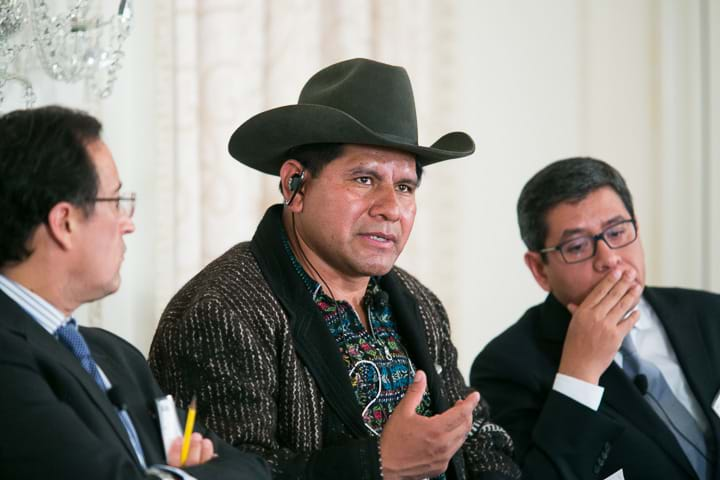
Myriam Méndez-Montalvo served as representative for the Andean Region and Southern Cone until the end of January 2015.
The rapid expansion of extractive industries in recent years has transformed the economies, politics, well-being and landscapes of many parts of Latin America. While in some cases this growth has generated greater government revenue (and subsequently greater social spending) many of the most marginalized people are being left out. In particular, indigenous communities have faced loss of land and livelihood opportunities, as well as multiple other rights violations related to the environment, health, labor, civil and political rights. This situation of exclusion has resulted in increasing social conflict—and even violence.
In this context, consulta previa—the right of indigenous and ethnic groups to be consulted on matters affecting their culture and heritage, established by International Labor Organisation (ILO) Convention 169—is “one of the defining issues in politics, economics and investment in the region,” according to Christopher Sabatini, senior director of policy at AS/COA and Editor-in-Chief of Americas Quarterly. The spring issue of Americas Quarterly (AQ) looks at how countries in the western hemisphere are implementing consulta previa, as well as stakeholders’ perspectives and the challenges to implementation in each country as governments and private industry raise concerns about violence and lost investments. With the support of the Ford Foundation, AQ carried out an investigative journalism project throughout 2013 and 2014 looking into how the consulta previa legal framework has evolved, as well as the experiences of Chile, Colombia, Guatemala and Peru in approaching implementation issues. Through interviews with community leaders, lawyers, government officials and companies, as well as a series of private roundtable discussions in each country, the AQ report shines a light on the current state of consulta previa in these countries.
On July 16 in New York City, a public panel marking the launch of AQ’s spring issue brought these issues to a U.S. audience. A diverse group of experts—including Alberto Chumil Julajuj, the indigenous Mayan mayor and authority of Sololá, Guatemala; Francisco Graziano, head of the Office of Institutional Relations at Grupo Camargo Corrêa; Ivan Lanegra, former vice minister of intercultural affairs for the Ministry of Culture of Peru; Robert Thompson, a U.S. lawyer currently working with the Peruvian superintendent of banking, insurance and private pension fund administrators; Francisco Veloso, the vice president of legal and corporate affairs at Antofagasta Minerals; and Andrée Viana Garcés, the former director of consulta previa at the Ministry of the Interior in Colombia—discussed how consulta previa might be strengthened across Latin America. Nearly 100 people tuned in via the AS/COA website to view a live webcast of the panel from the U.S., Canada, Peru and Chile.
Following the panel, a high-level dinner discussion brought together executives from Akerman LLP, Cementos Progreso, HSBC Bank, The Goldman Sachs Group, The Bank of Tokyo-Mitsubishi and the Argentine energy company YPF, as well as representatives from foundations and human rights groups, to consider the roles and responsibilities of the state, private sector and local communities in implementing consulta previa. While the purpose of ILO 169 is to protect the cultural heritage and rights of vulnerable Indigenous populations, some see consulta previa as an obstacle to more pressing economic and political concerns. But it is virtually impossible for any major investment project to succeed without the support of the communities most directly affected. With consulta previa comes the potential for greater investment stability, as well as peace among indigenous communities, government and the private sector.
Because countries are at different stages when it comes to legal implementation and regulation, practices vary widely between, and even within, nations. As panelist Ivan Lanegra explained during the public event, consulta previa has been successfully implemented and recognized in Peru’s Amazonian communities, while progress has been much slower in Andean communities—due in part to a lack of clarity about who qualifies as “indigenous.” The indigenous community and the state are both protagonists in consulta previa, noted panelist Andrée Viana, while the private sector and other parties play important supporting roles. Participants agreed that less successful cases are often the result of a lack of government capacity to carry out consultations and explain the requirements under law to companies and the general public, as well as a lack of capacity within indigenous community leadership.
Working in Colombia, Peru and Chile, the foundation’s Andean Region and Southern Cone office is helping to strengthen consulta previa by funding research about the legal framework and implementation of ILO 169, and supporting organizations that are working to encourage broader public participation in decisions about natural resource use. We support efforts to ensure that public policy is created and executed fairly and equitably, to strengthen the management of public revenue, and to improve transparency and promote constructive social dialogue among stakeholders in the extractive industries. When implemented properly, consulta previa can help to reduce conflict, protect the environment, uphold indigenous culture, and make investment projects less damaging and more sustainable. And it provides an opportunity for a long overdue dialogue between the state and indigenous communities.
